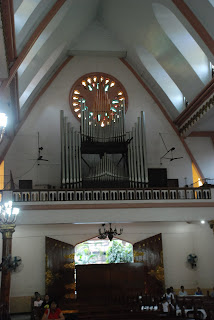








The disassembly of the pipe organ of Espiritu Santo Parish for its full restoration has been started today March 9, 2009. The pipe organ will be completely disassembled and transported to Las Pinas City where it will be professionally restored in the shop of Europe-trained Diego Cera Organbuilders, Inc.
First to be put in crates are the delicate metal pipes and the bellows. The biggest challenge though is to bring down the biggest pipes from the choir loft and transport it to Las Pinas. The longest pipe is about 18 feet long with a diameter of more than 1 foot. The pipe organ of Espiritu Santo is one of the few pipe organs in the country that has these big pipes which is quite valuable.
Another challenge is to bring down the heavy chests of the organ. There are two big chests each weighing about 400-500 kilos.
The disassembly of the organ took about 4 days. Friday, March 13, the whole organ now in smaller parts (relatively speaking) was loaded onto two trucks, a 20 footer truck and another 16 footer truck and transported to Las Pinas where Diego Cera has its shop.


